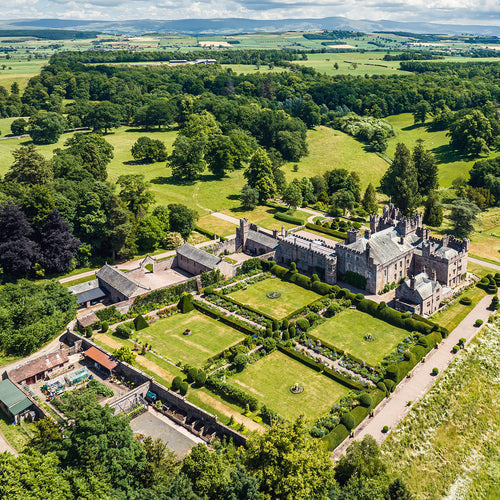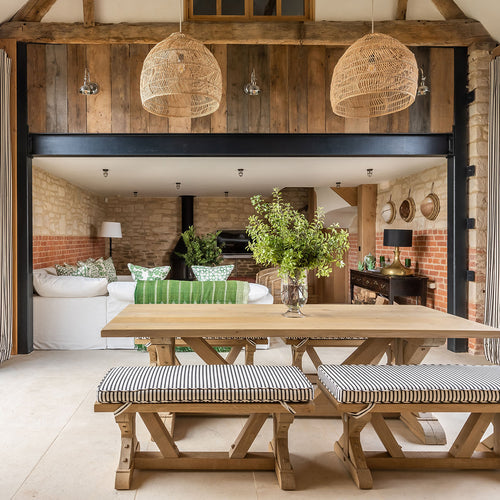THROUGH THE FAWN LENS
Creating Warm and Characterful Neutral Interiors

Images: Kennedy Nolan
The appeal of neutral interiors lies in their timeless quality and versatility. However, there's a common misconception that neutral means bland or lacking personality. Nothing could be further from the truth. When executed thoughtfully, neutral spaces can be rich with warmth, character, and texture - creating environments that feel both serene and deeply personal.
Finding Beauty in Simplicity
We often look to Japanese interior design philosophies, particularly wabi-sabi, which offer profound insights into creating spaces that feel both minimal and warm. Wabi-sabi embraces imperfection, impermanence, and the beauty of natural ageing. It's about finding beauty in simplicity and authenticity rather than perfection.
In practical terms, this might mean choosing a handmade ceramic vase with slight irregularities over a mass-produced perfect one, or appreciating the patina that develops on natural wood furniture over time. These elements bring soul to neutral spaces that might otherwise feel clinical.
Layering Textures for Depth
The secret to creating neutral interiors that don't fall flat lies in textural variety. Without bold colours competing for attention, textures become the stars of the show.
Consider combining:
- Rough and smooth (raw linen curtains alongside polished concrete)
- Matte and glossy (chalk-finished walls with glazed ceramics)
- Soft and hard (bouclé upholstery against timber flooring)
- Natural and manufactured (jute rugs with sleek metallic accents)
This interplay of contrasting textures creates visual interest and tactile richness that engages the senses without overwhelming them.

Image: RH England
The Power of Natural Materials
Natural materials form the cornerstone of characterful neutral interiors. Materials like wood, stone, clay, rattan, and linen bring inherent warmth and complexity to spaces through their natural variations and organic properties.
The principle of harmony with nature can be honoured through thoughtful material choices. Exposed wooden beams, stone flooring, clay pottery, and paper lanterns all reference natural elements while maintaining a neutral palette.
These materials age gracefully too, developing character over time rather than simply wearing out. A wooden table that shows the marks of family gatherings, or a leather sofa that softens and develops a rich patina through years of use—these elements tell the story of a home that's truly lived in.

Image: Rose Uniacke
Thoughtful Colour Selection
"Neutral" doesn't mean strictly beige or grey. A sophisticated neutral palette might include:
- Warm whites (ivory, ecru, oatmeal)
- Earth tones (terracotta, clay, sand)
- Muted greens (sage, olive, moss)
- Soft blues (slate, misty blue, dusty teal)
The key is choosing colours with similar saturation levels and undertones that harmonise rather than compete. Many contemporary interior designers incorporate muted, nature-inspired hues that create a sense of calm while still offering subtle variation - gentle pinks reminiscent of dawn skies, deep greens of forest moss, or the warm browns of autumn leaves.
Negative Space as Design Element
Embracing meaningful empty space between objects is a principle that transcends cultural boundaries. This approach teaches us that what we leave out is just as important as what we include.
In neutral interiors, allowing for breathing room between furniture and décor prevents the space from feeling cluttered or overwhelming. This intentional negative space creates rhythm and balance, allowing each carefully chosen piece to be appreciated fully.

Image: Stoffer Design
Lighting for Atmosphere
Thoughtful lighting transforms neutral spaces from flat to dynamic. An approach that favours soft, diffused light sources at various heights creates atmosphere and depth in ways that a single overhead light simply cannot achieve.
Consider:
- Paper or fabric lanterns that cast gentle, flattering light
- Low-level lighting that creates intimacy
- Natural light filtered through sheer materials
- Candles for warmth and movement
These varied lighting sources create subtle shadows and highlights that bring out the textural qualities of your neutral space.
Personal Touches with Meaning
Perhaps the most important element in creating a characterful neutral interior is the inclusion of items with personal significance. This approach encourages us to value and respect our possessions, keeping only what truly speaks to us.
Rather than following trends or filling spaces with generic décor, choose pieces that tell your story - family heirlooms, travel souvenirs, artwork that moves you, or handcrafted items made with care. These meaningful objects bring authenticity to your space that no designer showroom can replicate.

Image: Inigo
Embracing Change and Seasonality
Finally, embrace the changing nature of your home. Neutral interiors provide the perfect backdrop for seasonal adjustments - adding heavier textiles in winter, lighter elements in summer, or introducing subtle seasonal colours through natural elements like branches, flowers, or fruit.
This celebration of seasonality keeps your neutral space feeling fresh and responsive to the world around it, allowing for gentle evolution rather than dramatic overhauls.
Conclusion
Creating neutral interiors with warmth, character and texture isn't about following rigid rules but embracing principles that speak to our deeper desire for authenticity and connection. By incorporating elements that value simplicity, natural materials, thoughtful lighting, and personal meaning, we can create spaces that feel both timeless and deeply personal, serene yet full of character.
A truly successful neutral interior doesn't announce itself loudly but reveals its depth gradually, inviting closer inspection and rewarding attention with discovered details and tactile pleasures. It's an approach that values quality over quantity, meaning over trend, and creates spaces that feel not just designed, but truly lived in.



